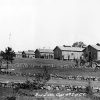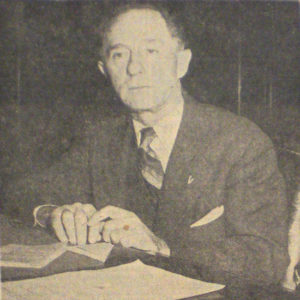calsfoundation@cals.org
Leslie L. Biffle (1889–1966)
Leslie L. Biffle was a national Democratic Party official from Arkansas. After serving as secretary for Arkansas congressional officials in Washington DC, Biffle became the Democratic Party secretary and finally the secretary of the U.S. Senate, serving from 1945 to 1947 and 1949 to 1953.
Leslie (or Les) Biffle was born on October 9, 1889, in Boydsville (Clay County) in northeastern Arkansas. His parents were William B. “Billie” Biffle, who was a local Democratic Party official, and Minnie Ella Turner Biffle. The family soon moved to Piggott (Clay County), and many today continue to cite Piggott as Biffle’s birthplace. Biffle attended schools in Piggott and Little Rock (Pulaski County).
In 1909, he moved to Washington DC to be secretary for U.S. Representative Robert Bruce Macon until 1912 and for U.S. Senator James Paul Clarke until 1916. From 1917 to 1919, Biffle served in France as an auditor for the U.S. War Department with the American Expeditionary Force. Returning to Washington, he continued his work in politics. He was a Methodist and a Freemason.
Biffle married Mary Glade Strickling of West Virginia in 1921.
In 1925, the Democratic leader of the Senate, Joseph Taylor Robinson, helped Biffle become the assistant secretary for the Democratic senators. Biffle then became the Democratic senators’ majority secretary in 1933. According to Life magazine, Robinson supposedly told Biffle, “Keep your eyes and ears open and your damn mouth shut,” while the Arkansas Gazette claimed Robinson had said, “Keep your mouth shut and your bowels open.”
As the majority secretary or “pair clerk,” Biffle arranged “pair votes” between absent Democratic and Republican officials. A bill before Congress sometimes lacked the necessary number, or quorum, of officials in attendance to be considered for a vote. As the majority secretary, Biffle would set up a “pair vote” in which an absent Republican’s vote was placed against an absent Democrat’s vote. This system ensured that bills received the necessary number of votes, while the “pair vote” canceled the two absent officials’ votes. With the volume of New Deal proposals, Biffle’s time as the majority secretary gave him invaluable experience navigating Washington politics and crafting national legislation.
In 1935, Biffle began a friendship with Missouri senator Harry S. Truman, and Biffle helped secure Truman’s nomination for vice president during the 1944 Democratic National Convention in Chicago, Illinois. In 1945, the Senate unanimously elected Biffle as secretary, an unprecedented move among both Democrats and Republicans.
When Republicans took the Senate majority in the 1946 elections, Biffle served as the Democratic Policy Committee’s executive director. During Truman’s 1948 election campaign, Biffle traveled through the Ohio and Mississippi River valleys. Oft-repeated accounts allege that Biffle dressed as a chicken farmer and drove a truck to poll voters, and Biffle’s analyses boosted Truman’s confidence during the close election.
From 1949 to 1953, Biffle again served as the secretary of the Senate. Due to his experience and relationships with Truman and congressional leaders such as J. William Fulbright, Biffle gained a reputation as a congenial and bipartisan political leader. As Senate secretary, he notified senators of congressional business, passed information among senators, relayed messages from the White House and congressional leaders, supervised congressional clerks and records, and assigned desks to congressional officials.
Articles appeared on Biffle in Newsweek, Fortune, Life, and the Washington Social Register, and magazines credited Truman with saying, “Les is worth ten votes on a roll call.” Anecdotes highlighted his office’s direct phone line to the White House and his walking the Senate’s aisles while whispering to congressional officials without moving his lips.
In 1949, Piggott leaders honored Biffle by naming that year’s Piggott Fourth of July Picnic “Les Biffle Day.” Attendees included Fulbright, Governor Sid McMath, and various federal and state officials. At the event, Vice President Alben W. Barkley debuted a bronze bust of Biffle, sculpted by Felix Weihs de Weldon, known for having sculpted the Iwo Jima Monument in Washington. The bust of Biffle stands at the Piggott Post Office.
Upon leaving the Senate, Biffle worked as a political consultant until he died on April 6, 1966. He is buried in the Fort Lincoln Cemetery in Maryland.
For additional information:
“Biffle: Remembering the Man beyond the Bronze.” Clay County Times-Democrat, February 15, 2006. Online at http://www.cctimesdemocrat.com/story/1374673.html (accessed September 7, 2021).
Butterfield, Roger. “Leslie Biffle.” Life, June 10, 1946, pp. 65–72.
“Ex-Secretary of Senate Dies.” Arkansas Gazette, April 7, 1966, pp. 1A, 2A.
“Leslie Biffle, Truman Confidant and Ex-Senate Official, Is Dead.” New York Times, April 7, 1966, p. 39.
Leslie Biffle Papers. Harry S. Truman Presidential Library, Independence, Missouri.
“Leslie Biffle, Secretary of the Senate, 1945–1947; 1949–1953.” United States Senate. https://www.senate.gov/about/officers-staff/secretary-of-the-senate/biffle-leslie.htm (accessed September 7, 2021).
“McClellan Adds Praise For Biffle.” Arkansas Gazette, April 7, 1966, p. 1A.
Aaron Coy Moulton
Fayetteville, Arkansas
 New Deal
New Deal Politics and Government
Politics and Government World War II through the Faubus Era, 1941 through 1967
World War II through the Faubus Era, 1941 through 1967 Leslie Biffle
Leslie Biffle 




Comments
No comments on this entry yet.